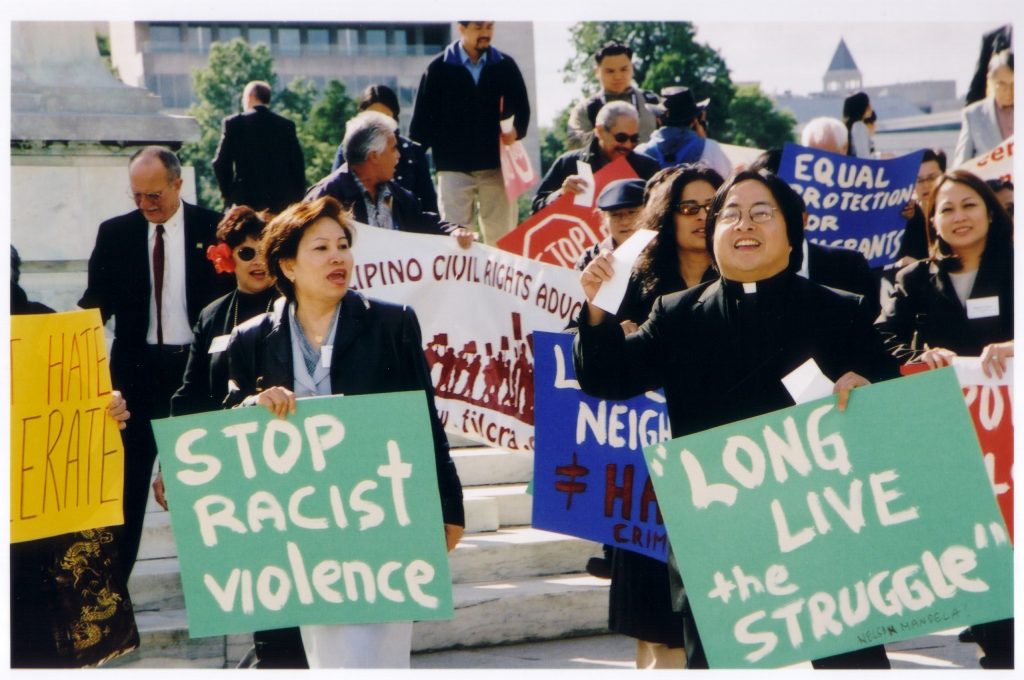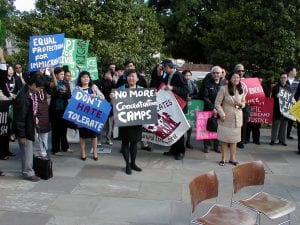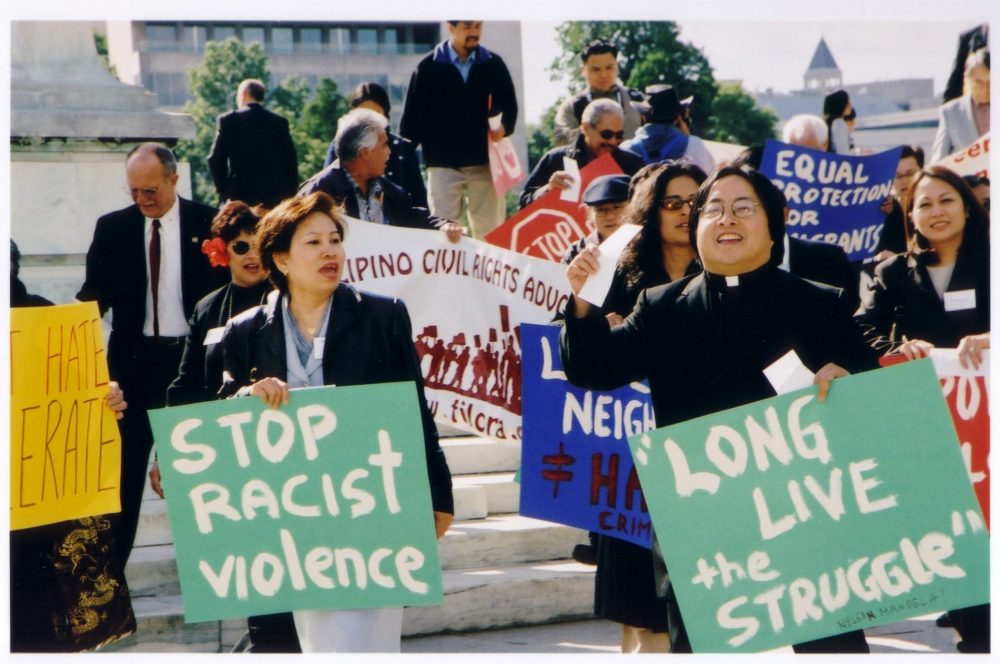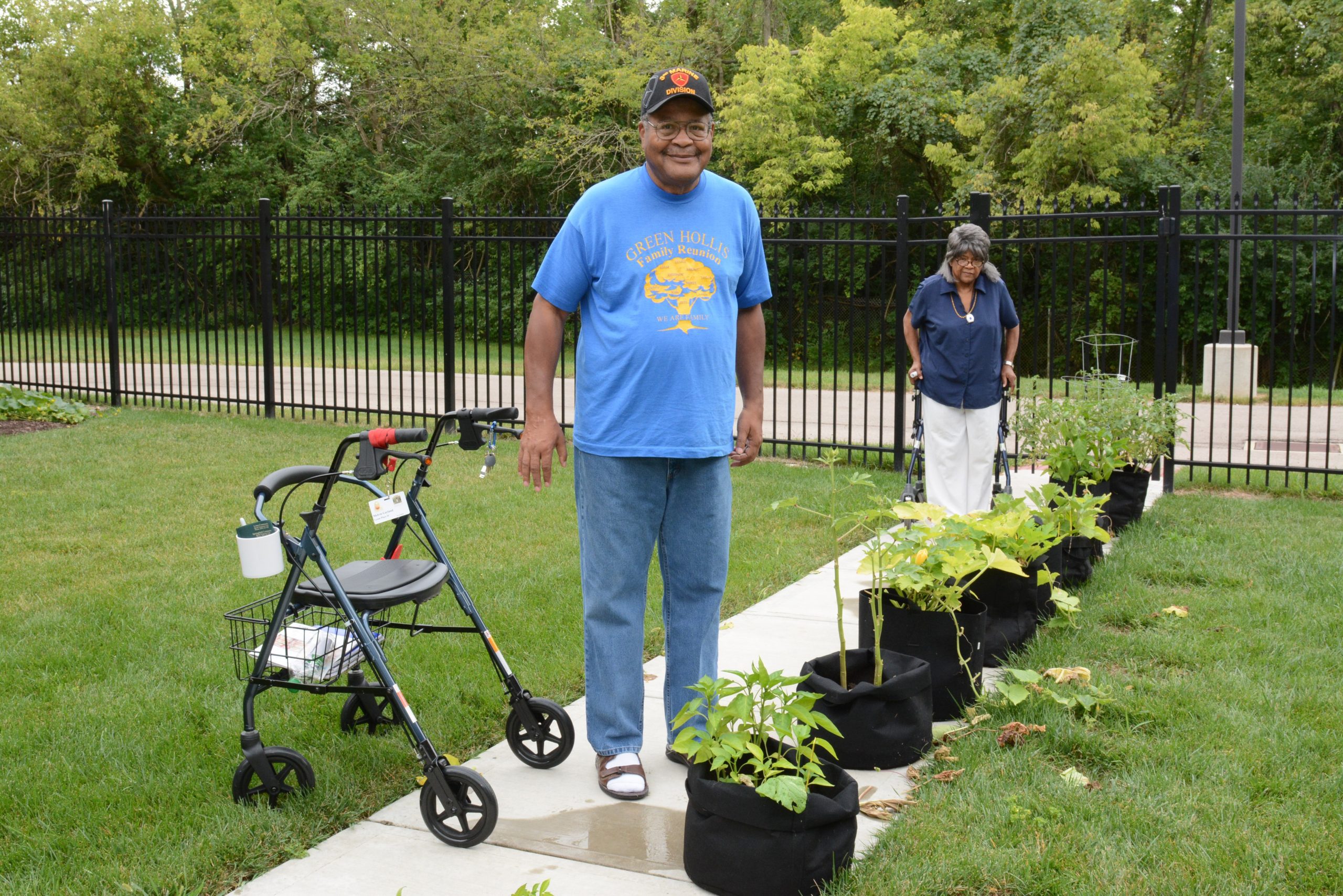
After the Sept. 11 attacks, the National Coalition for Asian Pacific American Community Development (CAPACD) organized rallies in response to discrimination, harassment, and violence toward Muslims and Asian-American people perceived as Muslim. Photo courtesy of National CAPACD
A woman riding on a train in Los Angeles recorded a man spewing a profanity-laced tirade about Chinese people.
The owners of a Chinese restaurant in Connecticut reported receiving racist death threats from two different phone numbers.
A Florida man posted a video on Instagram of him holding a bottle of sanitizer and harassing an Asian woman.
These are just three of the reportedly thousands of incidents of anti-Asian-American harassment, abuse, and assaults that have dramatically increased this year as COVID-19 cases mount in the United States and globally. Asian Americans of different ethnicities, largely not Chinese, have reported being barred from businesses and transportation, coughed and spat upon, targeted for attacks online, and more.
Advocates for the Asian-American community say the current crisis has led to the most widespread discrimination against them since the aftermath of the Sept. 11 attacks. But they’re combating the discrimination by using the infrastructure created before and after the 9/11 attacks to lobby for change and to connect the victims of discrimination with the resources they need, stepping in to help the community when the government can’t (or won’t), and highlighting how the attacks are not interpersonal acts but deeply connected to government-sanctioned animus toward Asian Americans.
Community leaders are confident they can battle what Kathy Ko Chin, president and CEO of Asian & Pacific Islander American Health Forum, calls “the twin viruses of racism and COVID-19.”
“Our country is guilty of consistently relying on Asian Americans for their contributions to #OurNeighborhoods and simultaneously avert responsibility to challenge harmful xenophobic rhetoric that impacts their ability to exist in this country without fear or concern,” said Seema Agnani, executive director of the National Coalition for Asian Pacific American Community Development (CAPACD), in a release.
Lessons: What Asian American Groups Learned After 9/11
As they deal with the new wave of discrimination facing their community, Agnani says Asian-American groups are applying the lessons they learned after the attacks of Sept. 11, 2001.

Courtesy of National CAPACD
The terror attacks created a crisis for the nation’s Muslims, and for Asian-American people perceived as Muslim. They became a frequent target for discrimination, harassment, and violence starting in the hours after the attacks destroyed the World Trade Center.
The first deadly assault came on Sept. 15, 2001, when Balbir Singh Sodhi, a Sikh-American gas station owner in Mesa, Arizona, was murdered by a man who had been heard spouting anti-immigrant rhetoric.
Overall the FBI reported 481 instances of anti-Muslim hate crimes in 2001. The year before, the total was 28.
It’s no surprise to Asian-American leaders that the COVID-19 outbreak has led to renewed attacks aimed at their community. They compare the current crisis not only to the aftermath of 9/11, but to the internment of Japanese Americans following the attack on Pearl Harbor and to the Chinese Exclusion Act of 1882.
“There’s always this sense of wanting someone to blame during a crisis and it’s usually those who are seen as the ‘other,’” says Deepa Iyer, a strategic adviser at Building Movement Project and director of Solidarity Is.
One important difference between now and 2001 is the level of communication about nationwide discrimination and harassment. Twenty years ago, the internet as we know it today was nascent. There was no Facebook, no Twitter, and few outlets available to trumpet what was happening to Asian-American people across the United States and allow for more rapid response to those hate crimes.
Now, groups are collecting that information for the world to see how much the community has been impacted. Stop AAPI Hate—co-founded by the Asian Pacific Policy and Planning Council, Chinese for Affirmative Action, and San Francisco State University’s Asian American Studies Department—allows anyone to fill out incident reports, available in nearly a dozen languages, so it can compile the flood of reports of COVID-19-relation discrimination and analyze the results to find trends and hot spots of discrimination.
Stop AAPI Hate says it has received over 1,100 reports from Asian Americans across the country since March 19, two months after the United States had its first reported coronavirus case. In all of 2018, the last year for which data is available, the FBI reported 174 anti-Asian hate crimes nationwide.
Iyer says another lesson learned after 9/11 was the importance of well-funded organizations to act as conduits for information and lobbyists for change. In 2001, South Asian Americans Leading Together (SAALT), a national organization that Iyer ran at the time, was volunteer-based. The aftermath of 9/11 taught Iyer that it is critical for community-based infrastructure to be well resourced and well reported, she says.
“It’s very difficult to respond to a crisis while you’re building the basic foundation you need for an organization,” Iyer says.
SAALT now has a paid staff. Its current executive director, Lakshmi Sridaran, says the change allows the organization to “shift from a national security framework to a racial justice framework because we are in meetings, coalitions, and constant relationship with other communities addressing a range of issues,” Sridaran says. “SAALT has expanded from rapid response to hate crimes in the wake of a major crisis to developing a robust agenda on civil rights and immigrant justice over these years.”
There are still lessons to be learned and improvements to be made, according to Annetta Seecharran, executive director of Chhaya CDC, who in 2001 was running a group called South Asian Youth Action. Seecharran says as she watched the coronavirus crisis begin to unfold, she felt a pang of déjà vu.
“I thought, why does this seem so familiar?” she says. “We are unprepared, we don’t have capacity, we don’t know how to respond.”
Loss of Business
Communities of color in the United States were hurting long before COVID-19 cases began mounting here, says Chin of the Asian & Pacific Islander American Health Forum, based in Oakland, California.
“Now we’re hurting in a big way and all of those hurts are revealed for the whole world to see,” Chin says.
The hurt isn’t solely because of racist harassment and assaults.
Restaurants and businesses nationwide saw business drop before quarantines and stay-at-home directives took effect. Take the Chinatown International District in the Puget Sound region in Washington state, for example. Of the more than 400 businesses there, 140 are restaurants that have had a significant loss of revenue since January, when the first COVID-19 case was confirmed in Washington, according to the Seattle Chinatown International District Preservation and Development Authority. (There is now a grant fund established to offer some relief to those businesses.)
Asian Americans for Equality says restaurant and business owners in New York are facing the biggest challenge since 9/11 as they’ve seen business drop up to 80 percent since the virus began sweeping through the country. (Its affiliate, Renaissance Economic Development Corporation, had started a relief loan fund to help those businesses. The first round of grants has closed.)
Truman Lam, owner of New York City’s largest Chinese restaurant, Jing Fong, told NPR in March he too started seeing a dip in business in mid-January. Lam closed the restaurant entirely on March 10. Business owners told The Gothamist that Chinese restaurants in the New York region shuttered because of a shortage of workers worried about catching the virus and the closure of food suppliers in Manhattan’s Chinatown.
While there are some loans and emergency funding opportunities available to businesses, CAPACD told Shelterforce that it doesn’t want to see only loans provided to AAPI businesses that have been hard hit by the COVID-19 crisis.
Getting Resources Where They’re Needed
There are also challenges delivering health care, wellness advice, and virus warnings to Asian-American communities, illustrated by the large Marshallese population in Arkansas. Here community groups stepped in where the government did not.
A 1986 agreement between the United States and the Marshall Islands gave the U.S. military access to the Pacific Island nation, while the Marshallese received the right to work and live in the U.S. without visas. That has led to about 20,000 Marshallese settling in the U.S. The largest enclave is in northwestern Arkansas.
Over 75 percent of Marshallese families are considered low income and 52 percent live in poverty, according to the 2010 Census. More than 50 percent do not speak English well, the Census says. These families are not eligible for Medicare or Medicaid. Along with their culture’s propensity for large gatherings and, according to a 2015 study published in the American Journal of Public Health, widespread health issues, the Marshallese are uniquely vulnerable to COVID-19.
Yet when the virus began spreading throughout the United States, the federal government and Arkansas officials did not translate COVID-19 directives and resources into Marshallese, according to Chin. That means warnings about how to avoid contracting the disease, potential stay-at-home orders, and directions on testing were all written in a language native-speaking Marshallese could not read.
The Arkansas Coalition of Marshallese took action, hosting a fundraiser to get the information translated, which was successful but delayed the response to that population. The group has posted translated COVID-19 advisories on its Facebook page.
The federal government, not struggling nonprofits, should be making sure the nation’s non-English-speaking population gets the coronavirus resources they need, Chin says.
“This is no way to run pandemic response,” she says.
The Asian & Pacific Islander American Health Forum has launched a new program it hopes will help. Called Community Care Package, it’s a newsletter that provides the group’s network of community organizers with information and resources on technology and telecommuting, nonprofit relief from the federal stimulus bills, advice on how to care for staff during times of declining revenue, and more.
The Connection to Health
Underlying health issues are contributing to the poor health among American’s Marshallese population and other marginalized communities. According to public health experts, discrimination is also a factor.
“Racism can make people sick, as in literally sick,” says Gilbert Gee, a community health sciences professor at UCLA Fielding School of Public Health.
Gee cites research showing that even seemingly minor slights like being treated unfairly can have a spillover effect, manifesting itself physically in maladies such as weakened immune systems. He says his own research shows discrimination can cause depression, suicidal thoughts, respiratory illnesses.
Discrimination can lead to poor health in other ways. Richard Besser, president and CEO of Robert Wood Johnson Foundation and a former acting head of the Centers for Disease Control and Prevention, said during a call with reporters that it’s absolutely clear that communities of color who live in underinvested areas of rural and urban America are hit hard when a pandemic strikes because of “where they sit in our economy.” Can they work from home and social distance, or do they have to go to work and risk infection?
“These are people who have started behind and when a crisis like this starts, they’re hit the hardest,” Besser says.
Discrimination Starts at the Top
For many in the Asian-American community, the No. 1 factor leading to increased targeting of them lives in the White House.
President Trump’s repeated use of the phrases “Wuhan virus” and “China virus” in particular is like pouring gasoline on a fire, they say.
Scot Nakagawa, a senior partner at Seattle-based think tank Change Labs, said at a recent town hall hosted by the People’s Collective for Justice & Liberation that the president uses these phrases both to evade responsibility and to send a message to his base of supporters.
“When Donald Trump talks about this Chinese virus, China in this is also a proxy for globalist, which is kind of a dog whistle that is anti-Semitic,” Nakagawa said. “It is also going to be used to educate people to think and act in ways that are likely to cause broad-scale targeting, not just of those of us who will be perceived to be Chinese.”
Trump’s potential successor isn’t winning any fans among Asian-American activists either. When former Vice President Joe Biden released a campaign ad in April saying Trump “rolled over for the Chinese,” Cecillia Wang, a deputy legal director at the national ACLU, accused Biden of “trying to out-Trump Trump.”
“This kind of fearmongering is causing violent attacks on Asian Americans,” Wang said on Twitter.
According to Gee, in an analysis of 1 million tweets, tweets with negative speech regarding racial groups dropped by 4 percent from November 2019 to March 2020, while negative tweets about Asians rose 70 percent. Anti-Asian messages on the social media site went up 167 percent after Trump started referring to the coronavirus as the “China virus,” Gee says.
And just as racist hatred of Muslims after 9/11 led to attacks on non-Muslim Asian Americans, rising racial animosity related to the spread of the COVID-19 is not limited to just Chinese Americans, Gee warns.
“For many people animosity against Chinese [is] directed towards other Asians such as Koreans and Vietnamese,” he says. “And this is because for many people quote unquote all Asians look alike.”
Sridaran of SAALT says one thing she regrets about the post-9/11 period is that Asian-American groups could not stop the rapid characterization of Muslims as terrorists, and she sees something similar at play with the anti-China rhetoric on display today.
The acts of violence and hate directed at Asian Americans after 9/11 and during the COVID-19 crisis are not interpersonal acts of aggression, she says, but are deeply tied to state policies. Just as the targeting of Muslims following 9/11 was connected to the United States’ push for war with Muslim-majority countries, so the recent spate of anti-Asian American discrimination is tied to the Trump administration’s anti-China rhetoric, she says.
SAALT has advanced this analysis in the last five years mainly through federal legislative advocacy on hate violence, plus two recent reports summarizing trends from its hate violence database. Asian American groups and leaders need to make these links explicit, she says.
“We need to make sure that we [are] making that direct link and not saying, oh this one person just happened to call this other person a slur and shoot them or damage their property,” Sridaran says.
Iyer is not entirely pessimistic that the effect of coronavirus-related discrimination will be as bad for Asian-American communities as it was after 9/11, when the attacks led to a brutal campaign by the United States that Iyer says “ensnared Muslim and Black and brown communities” across the globe.
What gives her hope, Iyer says, is seeing young people fresh out of college working with the mutual aid and community defense organizing that is springing up organically nationwide to help victims of discrimination in this new age.
“A lot of learning that’s going on,” she says.





Comments